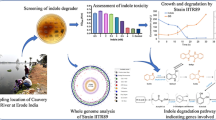Abstract
An indigo-producing strain was isolated from activated sludge and identified as Comamonas sp. based on 16S rRNA analysis. It produced indigo at 26.5 mg/l with a conversion of indole to indigo of 47%. Indole at 50 mg/l plus 200 mg naphthalene/l gave 32.2 mg indigo/l with a 58% conversion. A pathway for indigo formation is proposed. This is the first study of indigo biosynthesis by Comamonas sp.



Similar content being viewed by others
References
Bechtold T, Turcanu A, Geissler S, Ganglberger E (2002) Process balance and product quality in the production of natural indigo from Polygonum tinctorium Ait. applying low-technology methods. Bioresour Technol 81:171–177
Bhushan B, Samanta SK, Jain RK (2000) Indigo production by naphthalene-degrading bacteria. Lett Appl Microbiol 31:5–9
Doukyu N, Aono R (1997) Biodegradation of indole at high concentration by persolvent fermentation with Pseudomonas sp. ST-200. Extremophiles 1:100–105
Ensley BD, Ratzkin BJ, Osslund TD, Simon MJ, Wackett LP, Gibson DT (1983) Expression of naphthalene oxidation genes in Escherichia coli results in the biosynthesis of indigo. Science 222:167–169
Gray PMM (1928) The formation of indigotin from indole by soil bacteria. Proc Roy Soc Lond Ser B 102:263–280
Han GH, Bang SE, Babu BK, Chang M, Shin H, Kim SW (2011) Bio-indigo production in two different fermentation systems using recombinant Escherichia coli cells harboring a flavin-containing monooxygenase gene (fmo). Process Biochem 46:788–791
McClay K, Boss C, Keresztes I, Steffan RJ (2005) Mutations of toluene-4-monooxygenase that alter regiospecificity of indole oxidation and lead to production of novel indigoid pigments. Appl Environ Microbiol 71:5476–5483
Meyer A, Würsten M, Schmid A, Kohler HP, Witholt B (2002) Hydroxylation of indole by laboratory-evolved 2-hydroxybiphenyl 3-monooxygenase. J Biol Chem 277:34161–34167
Murdock D, Ensley BD, Serdar C, Thalen M (1993) Construction of metabolic operons catalyzing the de novo biosynthesis of indigo in Escherichia coli. Biotechnology 11:381–386
O’Connor KE, Hartmans S (1998) Indigo formation by aromatic hydrocarbon-degrading bacteria. Biotechnol Lett 20:219–223
O’Connor KE, Dobson ADW, Hartmans S (1997) Indigo formation by microorganisms expressing styrene monooxygenase activity. Appl Environ Microbiol 63:4287–4291
Qu YY, Pi WQ, Ma F, Zhou JT, Zhang XW (2010) Influence and optimization of growth substrates on indigo formation by a novel isolate Acinetobacter sp. PP-2. Bioresour Technol 101:4527–4532
Acknowledgments
The authors would like to thank the National Natural Science Foundation of China (Nos. 21176040, 51078054 and 20923006), and the Open Project of State Key Laboratory of Urban Water Resource and Environment, Harbin Institute of Technology (No. QAK201009) for their financial supports. We also thank the EssayStar Company (http:www.//essaystar.com/) for their English language editing.
Author information
Authors and Affiliations
Corresponding author
Electronic supplementary material
Below is the link to the electronic supplementary material.
Rights and permissions
About this article
Cite this article
Qu, Y., Zhang, X., Ma, Q. et al. Indigo biosynthesis by Comamonas sp. MQ. Biotechnol Lett 34, 353–357 (2012). https://doi.org/10.1007/s10529-011-0778-2
Received:
Accepted:
Published:
Issue Date:
DOI: https://doi.org/10.1007/s10529-011-0778-2




